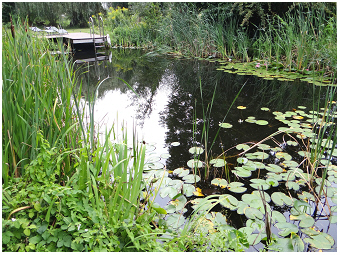About designed
water retention basins:
natural swimming ponds and wildlife ponds
what do lakes and natural swimming ponds have in common?
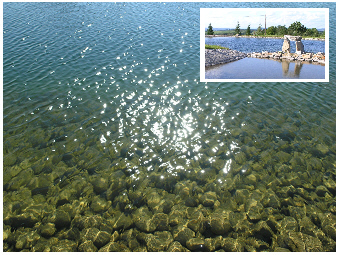 Natural swimming ponds, Ried in Innkreis,
Austria, 2006:
Natural swimming ponds, Ried in Innkreis,
Austria, 2006:
Connected swimming ponds of varios size and depths invite people for
bathing in summer.
Creating a pond can be fascinating
for many
of us! Some want to enjoy a
small
pond in the immediate living
environment, located right next to the terrace, on the
lawn or in the
more secluded garden wildlife area. Life in a pond changes a lot with
seasons! Visiting a nearby pond throughout the year puts us in
touch with nature and
gives us the opportunity to experience the
four seasons in our daily life even if we live in urban surroundings.
Others may decide to construct a pond as an attraction for
visitors or tourists.
Ponds are artificial stagnant water basins. Ponds have for long been
popular, even if the reasons for creating them, and the methods of
construction, have changed over time.
In the past ponds were mainly created for agriculture, to extract peat,
clay and gravel or to protect against floods. Such ponds are known as
village pond, mill pond, horse pond, duck pond, reservoir for flood
control (see page about Biotop
Auersthal S),
groundwater-seepage pond,
fishpond, peat pond (see page about
Bergknappweiher S) and loam pit
pond of a brickyard. These ponds were created as part of the tradition
and cultural life-style of local people. Some of these ponds still even
exist today, even if they don't serve their original purpose any
longer. They
can be valuable habitats for nature, the ecologically inferior to
the natural small water bodies
such as peat-bog lakes, kettle holes or
other
small lakes. In these ponds the basin is mainly build from naturally
occurring local material, such as a waterproofing layer made of clay or
natural stones, peat or sand. These ponds-for-life
compare well with
lakes
that are defined as natural stagnant waters.
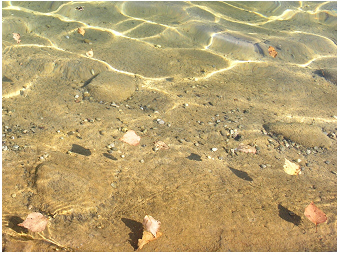 Natural swimming ponds, Ried in Innkreis,
Austria, 2006:
Natural swimming ponds, Ried in Innkreis,
Austria, 2006:
The bottom of this large pond basin looks natural. This pond and other
ponds operating as a swimming pond cluster attract many hundreds of
people for swimming and bathing in summer.
In this section of the lakeriver-Website,
however, we
deal with artificial water
basins,
which are less close to nature as the water is retained by pond
liner or concrete. In some cases
a container is
used to create the water
basin. These ponds are constructed by landscape planning to be a
valuable place for recreation, for bathing or swimming or simply to
attract wildlife in our parks, gardens or woods. In this situation
these
designed ponds are again used for different purposes. In the literature
such artificial water retention basins are commonly described as
‘natural swimming ponds’ and ‘wildlife ponds’. These descriptions
can
be
somehow misleading as we learned from the former paragraph that these
designed ponds are not that close to nature as the traditional ponds
created decades before. The name ‘natural’ might just refer to the fact
that it is commonly agreed that no chemicals are used to
clean up the pond water, quite different from the water
in a pool. In swimming ponds and wildlife ponds, biological
processes
mainly achieve the ‘cleaning’ of the water. The influence
of biology can easily be seen in some designed ponds as these elements
are also used for
decoration, as e.g. the green leaves of life plants or gravel pit on
the basin ground. In other ‘natural’ designed ponds, ‘biology’ is
still
part of the system even it cannot be seen at first glance as the
‘biological module’ is hidden by a sophisticated concept and well
executed design.
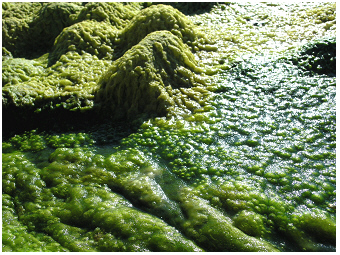 Natural swimming ponds, Ried in Innkreis,
Austria, 2006:
Natural swimming ponds, Ried in Innkreis,
Austria, 2006:
A closer look into a retention basin used for
phytoremediation to retain nutrients in a complex swimming
pond system with circulating water. Nutrients are retained here by the
uptake by filamentous green algae and diatoms. The latter can only be
seen under a microscope and are living attached to the surface of the
filamentous algae and on the bottom layer of the basin. The gas bubbles
seen in the foreground of the photo indicate oxygen produced by these
algae. These basins are most effective to remove phosphate even if the
phosphorus concentration is not yet detectable by standards
of chemical
analysis (detection limit
< 40 nanomol L-1).
The biomass
of these filamentous algae needs to be harvested from time to time
during bathing season to remove nutrients from the pond system.
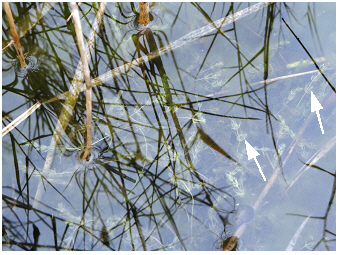 Shallow wildlife pond on the city area of
the University of Vienna, 2013:
Shallow wildlife pond on the city area of
the University of Vienna, 2013:
The concrete water basin became a valuable water habitat for many
plants and animals within the city for many years. This pond is
reminiscent of a reed belt in the shallow littoral zone of a
clear-water lake (high water transparency), a close-to-nature assembled regeneration
area of a
designed natural pond, or a separate phytoremediation basin
area connected by circulating water with swimming ponds. In
this situation the plants that are mainly responsible for removing
nutrients from the water
body and
hence avoiding the massive growth of floating photosynthetic
microorganims
(phytoplankton) are reed (mainly Phragmites
australis) and charophyte underwater vegetation
(e.g.
Chara spec., see
arrows).
Depending on the purpose and size of these designed artificial water
bodies, they are just a single pond basin without or with a small
regeneration zone or a cluster of few ponds
arranged together with integrated regeneration
zones or even with separate regeneration basins
(see for example Teubner et al. 2007 R,
R).
Some ponds are thus further connected to basins used for
phytoremediation retaining nutrients outside the main
basin. In these advanced and more complex artificial pond systems, the
water of the main basin is circulating through the regeneration zones
and phytoremediation basins (constructed
wetland with reed; shallow
water regeneration basins with
filamentous green algae, on this page see gallery fotos
11-14 and the foto above on leftside) before
re-entering again the
main basin. The efficiency of retaining nutrients can be also improved
when
'effectice microorganisms' ('EM')
are applied to the pond
water or
pond sediment as a single treatment or when applied in addition to
nutrient bounding by reed plants or filamentous green algae. A
first aim of the three suggested treatments in the regeneration and
phytoremidiation zones is to mobilize the nutrients (mainly achieved by
'EM', see for example Teubner et al. 2007 R,
R;
Teubner 2012 R).
Furthermore artificial ponds might be designed in in a way, that the
mobilized growth-available macro-nutrients are
preferentially incorporated by filamentous algae or higher plants,
which
can be easily yielded by removing biomass and thus aim to eliminate
nutrients from the water body of the pond system (biomass harvesting of
filamentous algae in the retention basins throughout the growing
season, Teubner et al. 2007 R,
R; alternatively,
cutting the reed stands in the shallow regeneration zone of the main
basin or constructed wetland in late autumn or winter). Such treatment
is key to balance the nutrient concentrations in artificial ponds as
these modified systems are much simpler in terms of nutrient cycling
than what is known from natural stagnant ecosystems. Surprisingly, in
small swimming
pond systems with
circulating water, the retention
time of water in the main basin is
commonly adjusted by pumps to be just one day. In natural stagnant
water ecosystems such a very short retention time, however, is not
found. As described on the website of flushed riverine lakes, the
theoretical water retention time is between 3 and 30 days (Grosser
Mueggelsee S).
In many
other lakes, the time needed for water renewal of the whole water basin
is even much longer and can exceed a period from months to years
(see water retention time for lake examples on the pages about
Ammersee S,
Attersee S, Hallstaetter
See S,
Mondsee S, Taihu S, Traunsee S
and Old Danube S).
In large natural swimming ponds
and also in shallow wildlife garden ponds the water retention time is
longer than one day (about one month to a year), and they are hence
more comparable to lakes than those discussed previously.
 Shallow wildlife pond in the wood
'Familienwald' in Strasshof, Austria, 2013:
Shallow wildlife pond in the wood
'Familienwald' in Strasshof, Austria, 2013:
Every little helps! Even small, this pond liner filled up with water
creates a habitat for many wild plants and animals throughout the
seasons and could thus be a hotspot of enhanced species diversity in
the wood.
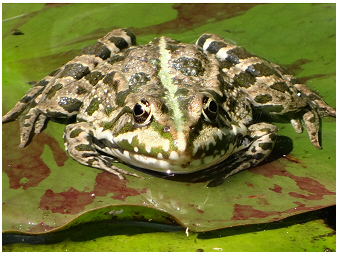 Shallow wildlife pond in the wood
'Familienwald' in Strasshof, Austria, 2013:
Shallow wildlife pond in the wood
'Familienwald' in Strasshof, Austria, 2013:
The frog is enjoying the sun in early summer!
Such shallow ponds are
easy to manage and are very effective: lots of joy for you and a
welcome place for wildlife in the wood, park or garden.
While many swimming ponds, at least those with a sand-gravel-filter,
look
‘promising’ the first three to five years later their water
body
turns becoming turbid due to floating micro-algae. In order to sustain naturally designed ponds,
much effort is commonly spent year
by year maintain the pond in its initial state. This includes emptying,
cleaning, re-filling and re-planting of the water basin at least once a
year, frequently changing filters or permanently utilizing additional
cleaning devices. Less technical support is needed in the situation
where a cascade of
biological processes achieves most of the purification
process. This website aims at understanding how to maintain a natural
pond in condition, while minimizing the cleaning treatments mentioned
previously. Ecological principles maintaining a good water
quality observed in lakes and watersheds ensure that a water body can
have high water transparency for years.
High water transparency points in two directions: indicating the ecological soundness
in an ecosystem on the one side, and being a marker for high quality of ecosystem services
on the other.
In this view, water transparency today is understood as
socio-ecological indicator,
which goes far beyond how we have seen water clarity in limnology
(Teubner et al. 2020 R,
Teubner et al. 2021 R,
pptx). Many lakes are well studied,
and some of them are the size of a large swimming pond.
Understanding natural aquatic ecosystems contributes to the
understanding of the main factors required for effective pond
management. The focus of this website is
thus to discuss pond management relation to what we have learned from
lakes and ponds in our landscape. The functionality and the rules for
creating and maintaining a designed pond are the purpose of this work,
not its architecture or specific instructions how to build a pond.
One question, however, couldn’t be answered here:
Which kind of pond is best suited to you?
It is up to you,
just to buy an entrance ticket to enjoy bathing at a public place or to
visit a lake for swimming in summer. Some prefer to build a swimming
POOL. An alternative would be to create your own lovely natural pond.
What matters most constructing and maintaining such a pond? And what
lakes and swimming ponds have in common? How can the knowledge about
lakes be applied to ponds? What organisms besides plants can
be
used to support the purification of water in designed swimming
ponds and natural ponds? These questions will be to be answered soon
in a greater detail on this website! This site about designed
ponds is still in preparation!
References: about swimming ponds
Teubner K, Teubner I, Pall K, Kabas W, Tolotti M, Ofenböck T, Dokulil MT (2021) New Emphasis on Water Clarity as Socio-Ecological Indicator for Urban Water - a short illustration. Extended Abstracts 14thIAD-conference:70-78 Look-Inside OpenAccess pptx
Teubner K, Teubner I, Pall K, Kabas W, Tolotti M, Ofenböck T, Dokulil MT(2020) New Emphasis on Water Transparency as Socio-Ecological Indicator for Urban Water: Bridging Ecosystem Service Supply and Sustainable Ecosystem Health. Frontiers in Environmental Science,8:573724 DOI:10.3389/fenvs.2020.573724 OpenAccess
Teubner K (2014) Schwimmteich oder See? - Naturnahe Teiche oder Schwimmteiche sind beliebte Gestaltungselemente in unseren Gärten und Parkanlagen. Wie unterscheiden sich diese künstlichen Gewässer von natürlichen Seen? Vortrag im Naturparkzentrum Heidenreichsteiner Moor, Waldviertel, Niederösterreich, May 2014
Teubner K (2012) Klar mit EM ... - Zahlenkosmos. Multikosmos, Heft Juli:22–23 Content: Essay about the application of 'effective microorganisms' (EM) in an artificial swimming pond system with three larger basins used for swimming and a varies cascades of retention basins, Eggerding, Austria. Look-Inside
Teubner K (2008) Algen – Lebens- und Standortbedingungen. Manuskript zum Schwimmteich-Vortrag auf dem BIONOVA Weltkongress, Kärnten Bad Bleiberg, January 2008
Teubner K, Ausserbrunner J, Watschinger G (2007) Verringerung des Phosphorgehaltes und die Aufrechterhaltung des hygienischen Standards eines Schwimmteichsystems im Öko-Camp bei Eggerding (Österreich). Kurzzusammenfassung vom Projektbericht:7pp Content: The reduction of phosphorus concentration and the maintenance of hygienic standards in a swimming pond system in the eco-camp at Eggerding (Austria). Extended Abstract:7pp Abstract Abstract in Greek Look-Inside
Teubner K, Ausserbrunner J, Watschinger G (2007) Verringerung des Phosphorgehaltes und die Aufrechterhaltung des hygienischen Standards eines Schwimmteichsystems im Öko-Camp bei Eggerding (Österreich). Content: The reduction of phosphorus concentration and the maintenance of hygienic standards in a swimming pond system in the eco-camp at Eggerding (Austria). Project report:53pp Content: Reduction of the phosphorus concentration and the maintenance of hygienic standards in a swimming pond system in the eco-camp at Eggerding (Austria). scientific report:53pp Abstract Look-Inside
